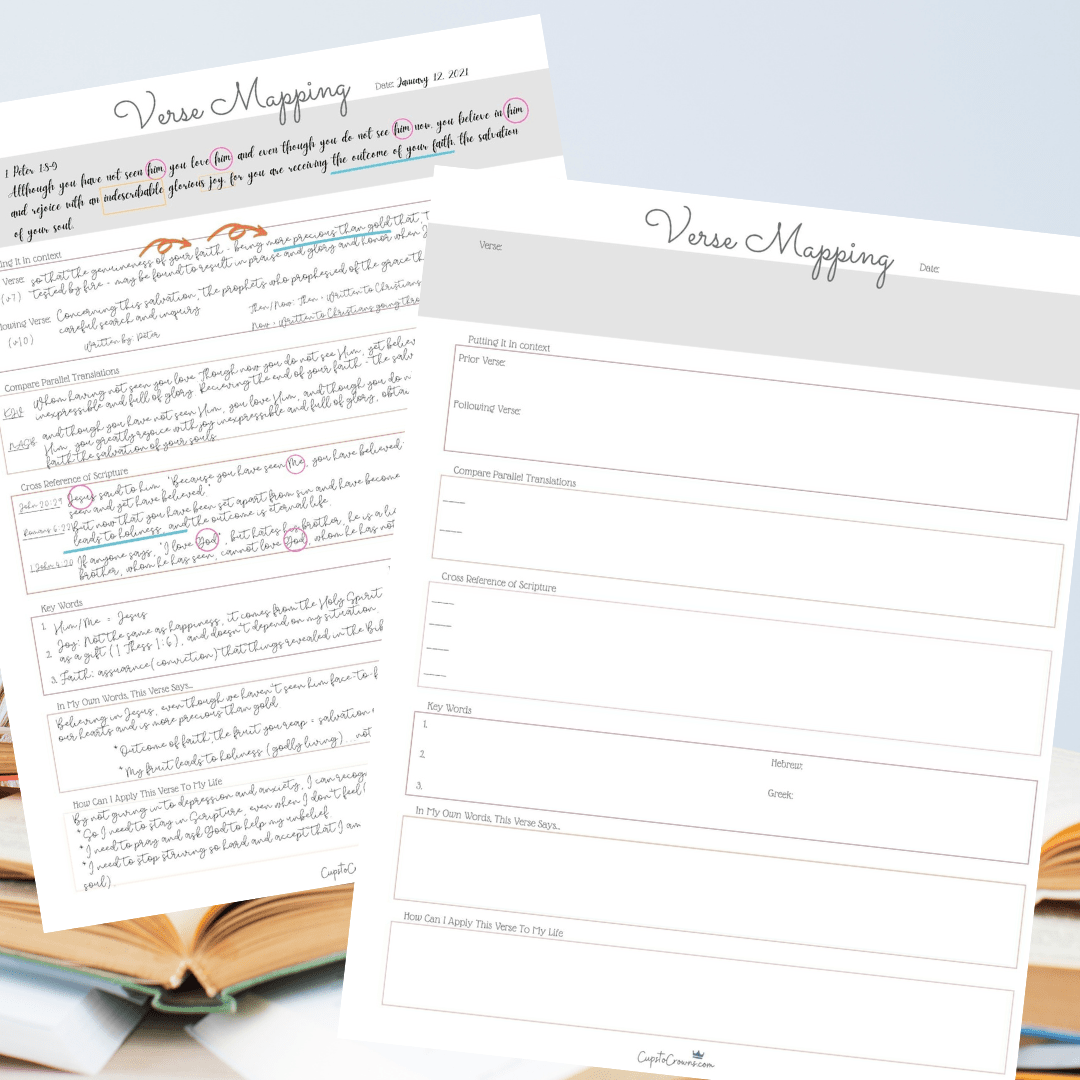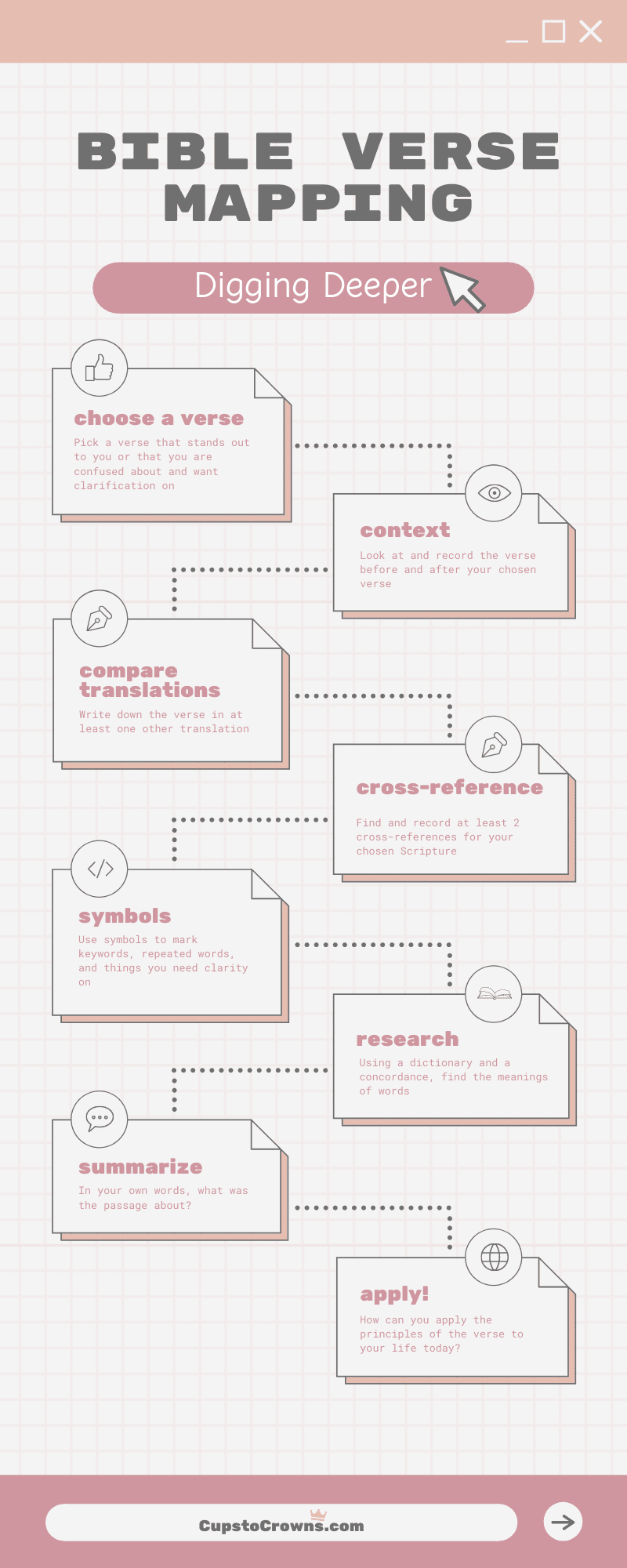Bible Verse Mapping for Beginners
Easy steps to Dig Deeper into Scripture
When I first heard the term “verse mapping” I thought it was pretty intimidating and a boring tool for serious seminary students. Life was crazy enough without me trying to add a super complicated study method to my mornings so I pretty much just ignored any reference to it.
One day I decided to just take a peek and see what all the fuss was about. To my surprise, the methods used to verse map were things I regularly did in my quiet time! I had just not put them all together into one study like this. I was hooked!
I‘ve been told that verse mapping is a relatively new term, but the principles behind it are nothing new.
I pray that this post will help you will find a new method of study that will allow the Holy Spirit to take you deeper into the heart of God.
What is Verse Mapping?
A map gives an overview of something and shows the relationship between elements.
Verse mapping is carefully examining the relationship between elements (Scripture) by pulling apart and examining context, cross-references, word meaning, etc to see how the elements fit into the whole. This allows the Holy Spirit to pull back the layers of your understanding to receive God’s truth in a way He knows you are ready to receive.
Why I like Verse Mapping
Verse mapping appeals to me because:
I have learned the hard way not to take verses out of contact.
I like anything that forces me to slow down and dive deep. When I do, I always learn tons. When you’re picking apart and mining the Bible for truths by researching anything you possibly can in a verse, you can’t help but learn more and more about God, yourself, others, and how the Bible fits together. All of those combined equal growth.
Anyone can do it. You don’t have to have it all figured out or have a seminary degree or years of knowledge to map out a verse of Scripture.
Verse mapping is wonderful for individual or group study.
Supplies Needed
Something to write on (notebook, this printable, a journal).
A variety of supplies to write with (pens, markers, highlighters).
Various Bible Translations (paper or online). (I prefer paper but my favorite when online is biblegateway.com).
A good commentary (my favorite is www.enduringword.com).
A concordance (paper or online). I prefer a paper concordance but when I am online I like the blueletterbible.org concordance).
How Long Does Verse Mapping Take?
That is up to you.
One day you might have 10 minutes to devote to your verse mapping and another day you might have an hour. As you work through the steps of verse mapping, you are writing it down. This allows you to stick with a verse doing a little here and a little there without having to complete a map in one sitting. You can easily come back where you left off.
I do this all the time. Because I can start and stop as time allows, I feel it is the best study method I’ve learned so far!
Verse Mapping Tips
Whatever conclusion you draw from your study needs Scripture to back it up.
Your study will look different than someone else’s study because each will reflect how God is speaking through His Word. However, the Biblical principles will not change.
Do what makes sense to you; highlight, underline, circle, box, or draw a star to denote certain things on your map. For example, you could use one color for Greek and one for Hebrew. You could underline repeated phrases and circle words that stand out to you. My best tip is to stay consistent throughout all your verse maps (for demonstration purposes, in my directions I share the symbols I use).
Don’t forget to date your map and store it in a page protector in a binder. Because I study a book at a time and a verse at a time, I use a binder for each book of the Bible and put my maps in verse order. If you study topically, you could put them in a binder alphabetically based on the book the study is from (Acts, James, 1 Peter, etc).
Always do what makes sense to you because you will want to come back to your study pages many times over the years. It will be so neat to do your study again and see how you have grown!
Verse Mapping Step-by-Step
I have created a verse mapping template (available in our Free Resource Library) to help you keep your thoughts together. However, you can use a plain sheet of paper. Do what works for you.
Step1: Preparation
Download and print off your printable template (or use plain notebook paper)
Pray. Always start with prayer! Bible Study is a Holy Spirit-led study
As you are studying a book of Scripture, pick out a key verse that speaks to you
Write out the verse on your printable
Step 2: Context Is Key
To help us avoid making assumptions, write out the verse that is before your chosen verse
Write out the verse that follows your chosen verse
Read those three verses as one. As you read, ask yourself questions:
Who wrote it?
What is happening in the passage? If your key verse is part of a story, give a summary.
Where is it happening at?
Who are the main characters?
Who said what?
Step 3: Draw Connections in Scripture
All verses in the Bible are connected to other verses; nothing stands alone.
Gather at least one other translation and look up your chosen verse. Write them out on your paper.
Using a concordance cross-reference where else in the Bible your verse can be found.
Step 4: Make The Map Your Own
Go back to your chosen passage again. What stood out to you?
Are there keywords or words you aren’t clear on the meaning of? Mark them with a circle.
Are there repeated phrases? Are they repeated across multiple translations and/or in your group of verses? Repeated words are always significant; underline them.
Anything unclear? Feel the need for further study? Maybe you want to check out maps, do a character study, or look into the history of a person or place. Remind yourself of your intentions by putting a star next to the thing you want to dig deeper into.
Step 5: Paraphrase
In your own words, what does the verse say? Write it down.
Step 6: Put It Into Action
What step of faith or act of obedience is God prompting you to take through this verse? This is important because we are to be doers of the word and not hearers only James 1:22).
Take your chosen passage and turn it into a prayer asking God to help you apply what you have learned. Thank Him for his wisdom and mercy. Sometimes I do this outlaid and sometimes I turn my verse mapping journal page over and write my prayer out.
For Additional Reading: Praying Scripture
In Conclusion
Verse mapping combines many study methods (writing out Scripture, searching word usage, cross-referencing, etc) into one highly powerful tool!
There is no one right way to study the Bible or do verse mapping; you can go deep and allow one study to morph into another (related) study or skim the top. Gather some tools together and dive into Scripture! As you practice this type of study it will become easier and you will gain confidence for your next study.
Your Turn
What other ways do you study the Bible? Have you tried verse mapping? What did you think?
If you enjoyed this article, I would be very grateful if you would comment, like, and share it.



